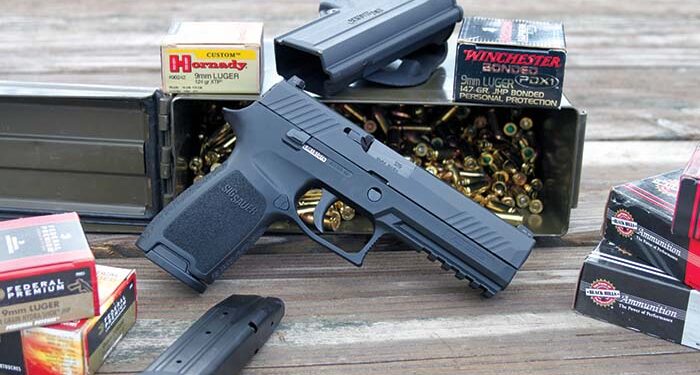By Todd Burgreen
The SIG Sauer introduction of the P320 striker fired handgun is a sure response to the U.S. market that continues to expand and generate firearm sales among both civilians and law enforcement consumers. The P320 was officially introduced in the U.S. at the 2014 SHOT Show; though as is often the case with new items in the firearms industry its pending arrival was known by many. SIG Sauer’s goal was to introduce the P320 with sufficient numbers available to consumers at the time of release – unlike so many products unveiled at SHOT with customers waiting over a year for the item to appear on dealer shelves. SIG should be commended for this and illustrates their upper management are not only businessmen, but also shooters relating to other shooters. The striker fired P320 is a departure from other SIG Sauer handguns such as the P220 and P226 series, which are more traditional hammer fired designs.


What is the difference between the more classical hammer fired handgun designs and the striker fired variants now taking over preponderance of serious use by LE and military units around the world? This is a valid question we can use to explore what the SIG P320 offers to its users as well as how handguns have evolved over the last 100 years. Firearm evolution is a slow tedious matter at times with breakthroughs and improvements coming in bits and pieces influenced by a multitude of factors such as manufacturing techniques, metallurgy, cartridge improvements, technology, market forces and countless other factors as experienced in individual countries and cultures. From the turn of the late 19th century semiautomatic handguns were typified by hammer fired steel frames and most likely single action in that the exposed hammer was cocked rearward when ready to fire. The Mauser 1896 “Broomhandle” and Browning 1911 serve as good examples of this. In the 1930s, double action hammer fired handguns arrived in force typified by the German P38 up to the Beretta M92 now serving U.S. military forces.
In the 1930s, the double-action/single-action (DA/SA) hammer fired handgun genre arrived in the form of the German P38. Its arrival was just as revolutionary as the striker fired Glock’s arrival 50 years later. The Walther P38 was spawned by the German military desiring a replacement for the classic Luger. The Luger’s tight tolerances, intricate interplay of many parts and unreliability when exposed to trench conditions were causes of this; not to mention the Luger’s high cost and low production capability due to the need for extensive hand fitting. German military planners requested the new handgun design be simple, with as few parts as possible. In addition, component interchangeability, ease of disassembly/assembly and reliability was also required. The P38 design concepts held sway until the 1980s until the advent of polymer framed striker fired handguns displaced those types. The function of the DA/SA trigger mechanism is similar to a DA revolver. The DA/SA trigger will cock and release the hammer when the hammer is in the down position, but, on each subsequent shot, the trigger will function as a single-action. On most DA/SA pistols there is the option to cock the hammer before the first shot is fired if time or situation permits. This removes the heavy pull of the double-action. The DA/SA hammer down carry on a live chamber with either safety engaged or not combined with longer heavier DA trigger pull reminds one of the revolver’s trigger, which was a much more familiar and considered inherently safer and less prone to accidental discharges. The DA/SA handgun design is still going strong today with numerous models being produced by multiple manufacturers. Excellent examples are the SIG Sauer variants being used by many police departments, federal agencies, and military units. While other early examples of DA/SA handguns are possible to find, the Walther P38 is considered by most the first widespread successful rendition.
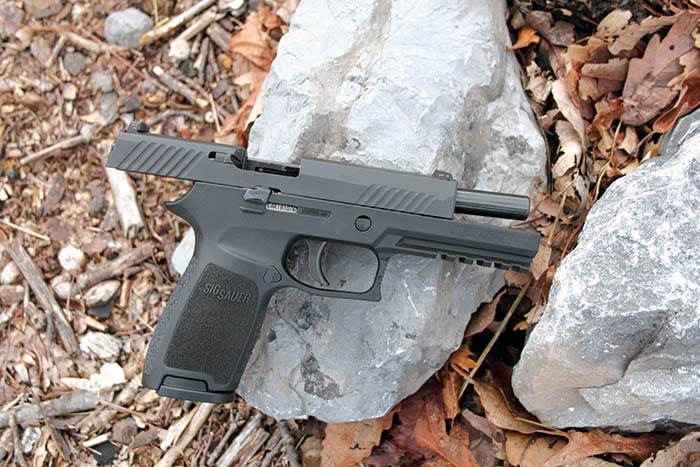
While examples of striker fired handguns predate 1982, this date is critical in that this is when the Glock striker fired handgun entered service. Though this is an article on the SIG Sauer P320, there can be little debate that semiautomatic handguns were redefined by the 9mm Glock 17 in terms of capacity and polymer construction. Polymer framed striker fired handguns are inherently lighter, thinner, and simpler due to the limited number of parts needed to make the gun. There are less large steel parts needed, such as a hammer in more traditional designs, thus there are less parts to break. This makes the gun easier to maintain, and more reliable. The relative quick adoption of striker fired weapons for LE use bears out this truth. The striker-fired weapon works without a standard hammer or firing pin that we can visible see in the first modern semiautomatic pistols. Instead, the firing pin, or “striker”, sits captive under some spring tension inside the slide while the gun is not being put through the firing process.
The P320 shares many of the design features of an earlier SIG offering the P250. Many felt the SIG P250 was a benchmark in handgun development when it appeared. Quite a bold statement that time will have to validate when viewed backward in future years. The SIG P250’s across the board modularity in terms of grip sizes, frame interchangeability combined with various slide lengths, multiple trigger positions, and caliber swapping heralded the next wave of high capacity polymer framed handguns. Gun culture members are by nature conservative and view new offerings skeptically until proven via use. The P250 found its reception somewhat cool in the U.S. market. The P250’s adaptability to individual shooter needs seemed too good to be true and the hammer firing mechanism affected a not very user friendly trigger. Time elapsed with SIG evaluating what could be done different to attract users. SIG knew its P250 concept was valid with its modularity, but turned to a striker fired design to breathe life into platform.
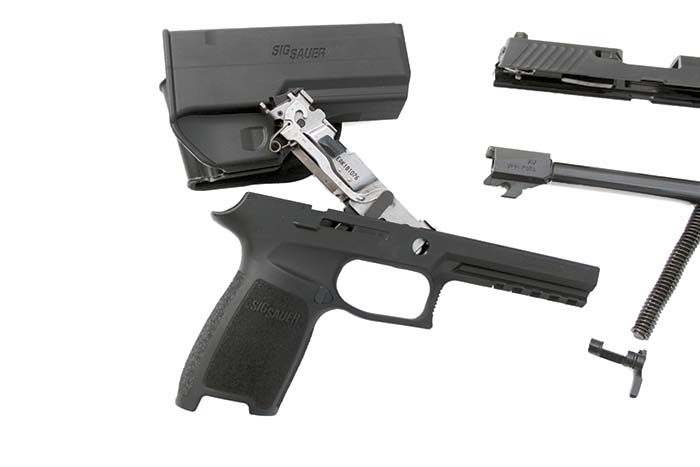
The P320 is currently available in 9mm (tested herein), .40 S&W, and .357 SIG with a .45 ACP variant in the works. The heart of the SIG P320 is the fire control mechanism or chassis. (For clarity sake, SIG refers to it officially as the frame assembly.) The chassis is considered the pistol and bears the required serial number marking. The chassis is the key component allowing for the SIG P320’s modularity. The fire control chassis fits into a grip module. Grip module sizes are labeled as “Full” and “Carry.” It is obvious to see the reasoning behind the titles. The grip modules are further adaptable to individual preference with three different grip circumference sizes available – large, medium, and small. An optional tabbed trigger safety complements the P320 modular package if required to meet certain agency specifications with the smooth trigger face standard. Rounding out the P320 ergonomic package are ambidextrous slide levers and the ability to switch the magazine release to either side of the frame.
The SIG P320 features a trigger pull measuring approximately 6 pounds. The key with the P320 is it is the same trigger pull every time. Overall, the P320’s trigger is an asset with its consistency. Anyone that dedicates the time to familiarize oneself with it will not be disappointed as it is similar to other striker fired weapons on the market. The fire control chassis aids in reducing the number of parts in the P320. The chassis contains the trigger mechanism, hammer, and slide catches. The slide assembly does not interact with the grip module, but is guided/operates along the chassis integral steel rails located on both sides of the chassis front and rear. The fire control chassis is easy to swap between grip modules without requiring any tools. Rotate the takedown lever and remove the slide. Remove the takedown lever by turning and pulling simultaneously. This frees the fire control for removal by pulling/pushing it upward while drawing the hammer backward allowing for the trigger to move into a position for it to move from the trigger housing. You are done. Reinsert into another grip module in the reverse order of direction. The SIG Sauer operating manual details this in only two pages; most of which is largely graphics. An important nuance pointed out in SIG literature is that the P320 can be field stripped without requiring either tools or needing to pull the trigger. Anyone who is familiar with what concerns law enforcement administrators knows this is an often heard gripe against some of SIG’s competitors for safety or logistic reasons.
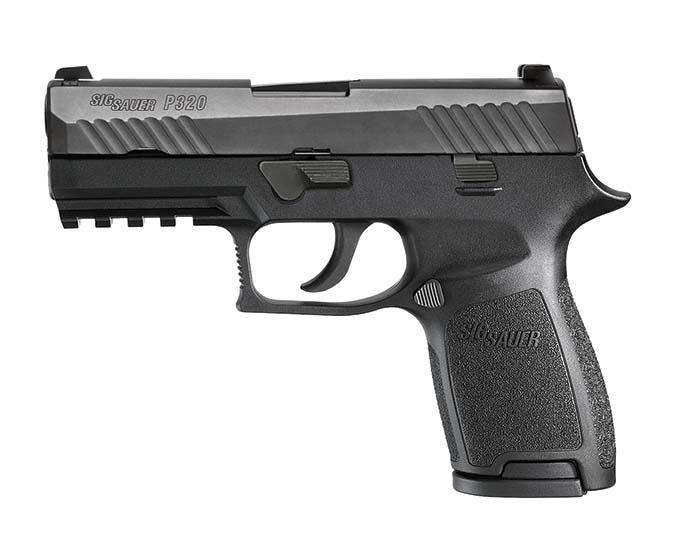
The SIG P320 Full model weighs 29.4 ounces without magazine and measures 8 inches in length, 5.5 inches tall, and 1.4 inches in width with a barrel length of 4.7 inches. For comparison’s sake, the P320 Carry model weighs 26.9 ounces without magazine and measures 7.2 inches in length, 5.1 inches tall, and 1.3 inches in width with a barrel length of 3.9 inches. The P320 come equipped with SIGLITE night sights with a Nitron finish on the slide. Both the Full and Carry P320 models feature an integral accessory rail dust cover. Magazine capacity of the P320 9mm Full size is seventeen rounds and the 9mm Carry fifteen rounds. Two metal magazines arrived with the P320.
It is best to think of the SIG P320 line-up of handguns as a “system” stretching from the Full to the Carry model. Every P320 shares a lineage back to the fire control chassis and similar striker fired trigger pull. Another key to the P320’s success in getting accepted will be its minimal operating controls, high cartridge capacity to size ratio, and relentless reliability. While the P320’s grip size may change based on user preference, the position of the slide and magazine releases will instantly be familiar. Simplicity should not be confused as lack of refinement. SIG Sauer reliability and solid performance is well regarded in the weapons community. Ideally, personal defense or service handguns should not be complicated by required manipulations in order to bring them to bear. This is a hallmark of most striker fired handguns with the P320 no exception.
The SIG P320 9mm was tested at the range first by verifying sight zero and then firing several magazines rapidly at various steel man targets. This quickly shows if any reliability issues exist as well as getting a feel for the trigger pull and reset. Further testing consisted of strings of fire against steel plate racks and popper targets at 7, 15, and 25 yards. The sights were zeroed in for 25 yards using the classic 6 o’clock hold. While a carry pistol’s reliability must be beyond reproach, carry ability is just as important considering the hours spent with the weapon holstered. The SIG P320 will find compatibility with most holsters made for the previous P250. In fact, the P320 arrived with a SIG Sauer Kydex holster that had P250 inscribed on it. A variety of Galco leather holsters are available for use with the P320 as well such as the Yaquii slide, Side Snap Scabbard, Stow-N-Go IWB, and Concealable Belt holster. The important point is blending retainage with accessibility. Remember the defender is reacting to an attack and must overcome the reactionary curve. Flexibility is the key to effective carry practices with Stow-N-Go IWB, Yaqui slide, and Belt slides all a part of a concealed carry practitioner’s repertoire. Galco magazine carriers and gun belts are not to be underestimated in importance either.
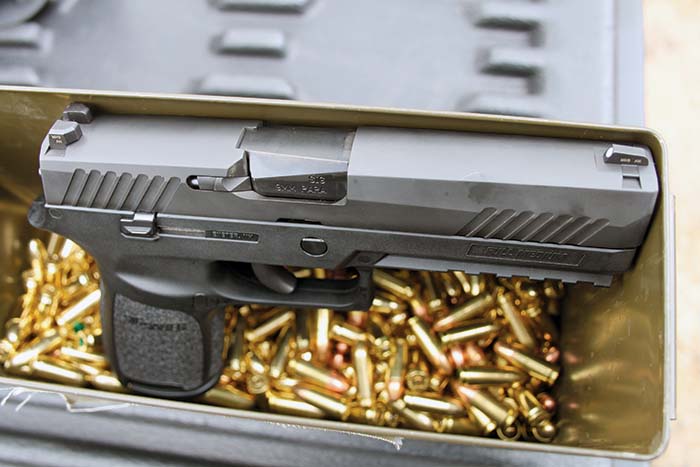
The SIG P320 tested herein was chambered in 9mm. Black Hills Ammunition, Hornady, Speer, Winchester, and Federal ammunition was used for range T&E. The SIG P320’s ergonomics and handling characteristics are quickly appreciated. No malfunctions with the SIG P320 were experienced while test firing over 500 rounds during range visits to Echo Valley Training Center (EVTC). Loads fired spanned 115gr to 147 grain with hollow points and FMJ bullet types utilized. The SIG P320 was also put through its paces by shooting a course designed for a LE competition held yearly at EVTC. Multiple targets are engaged from three different positions with mandatory magazine changes between firing positions. This gives a good benchmark for time and accuracy by being able to compare it to the average times posted by numerous competitors and their different weapons. Even under the induced stress of drawing against a timer and engaging multiple targets, the SIG P320 performed smoothly with the trigger conducive to accuracy or speed of placing multiple hits on target.
While appreciating firearm development trends, any future retrospective does nothing for us in the present if the SIG P320 does not perform in the here and now. The SIG Sauer P320 features mean nothing if it does not perform up to the standards SIG is famous for. It is truly a worthy handgun that is finding appeal with federal agencies and law enforcement departments based on its flexible modularity catering to shooters of all shapes and sizes. This is a dream of many law enforcement administrators attempting to pick one handgun model that suits every individual and job description in a department.
Sites of Interest
SIG Sauer, Inc.
18 Industrial Drive
Exeter, NH 03833
(603) 772-2302
www.sigsauer.com
Galco International
2019 West Quail Ave
Phoenix, AZ 85027
800-874-2526
www.usgalco.com
| This article first appeared in Small Arms Review V18N6 (December 2014) |



